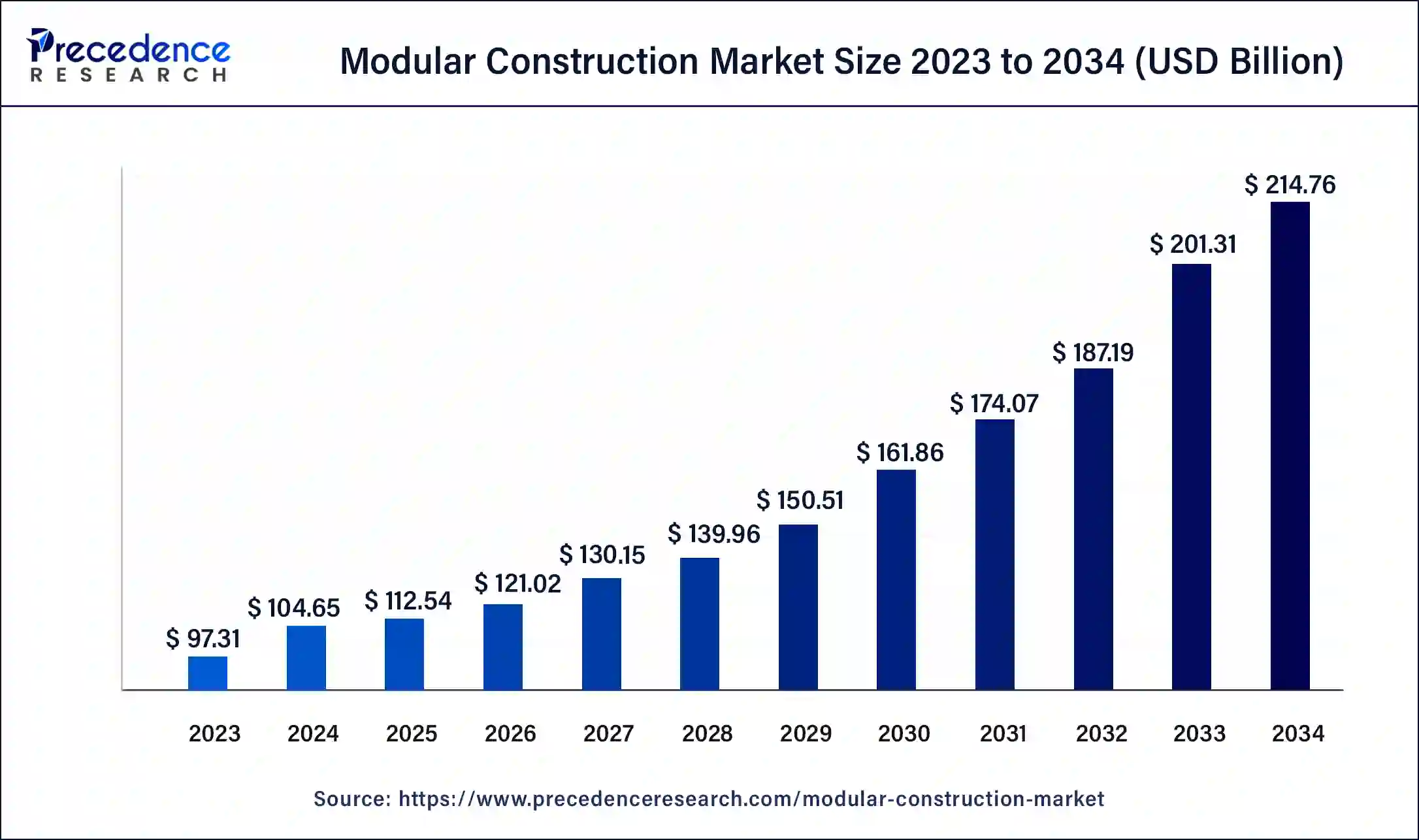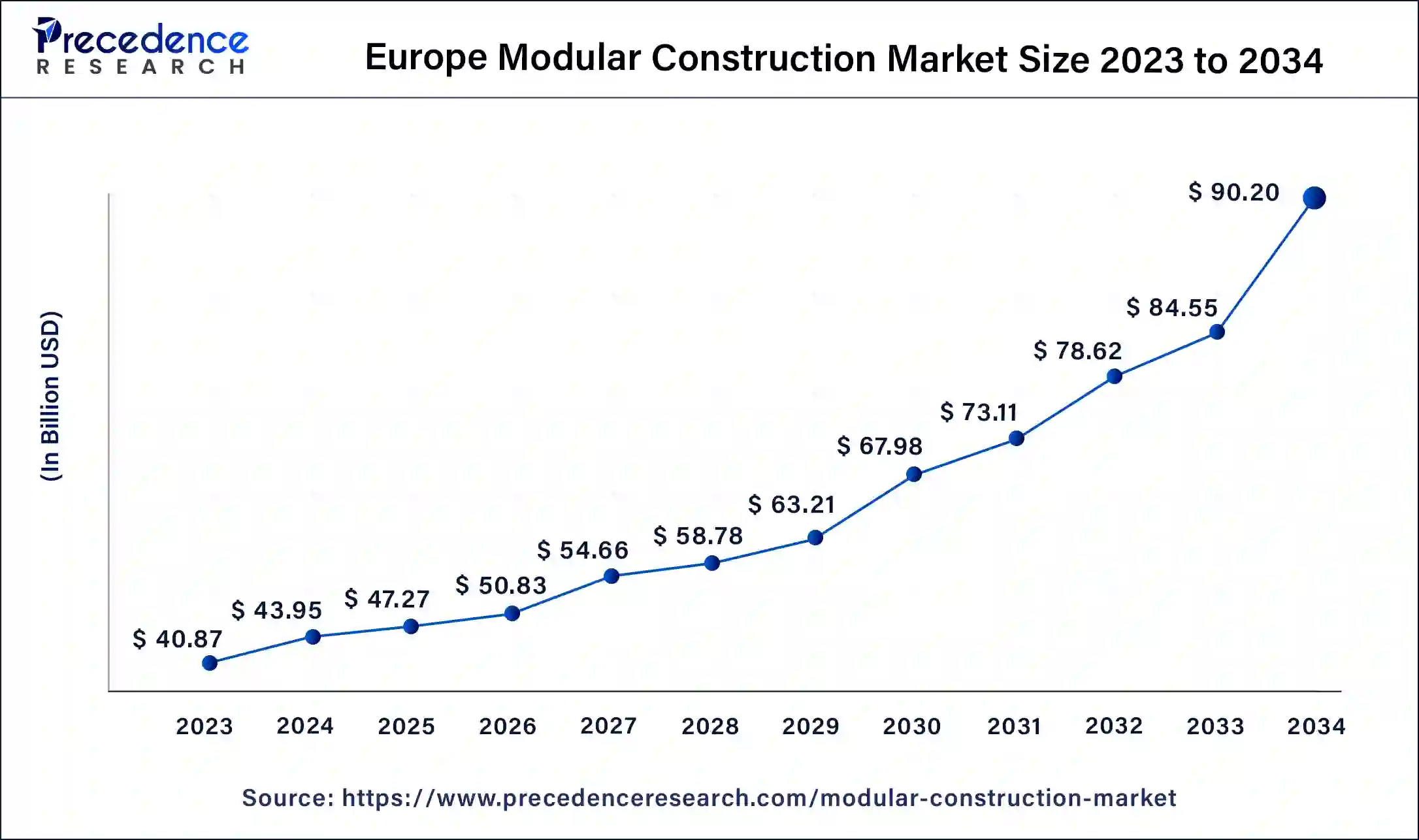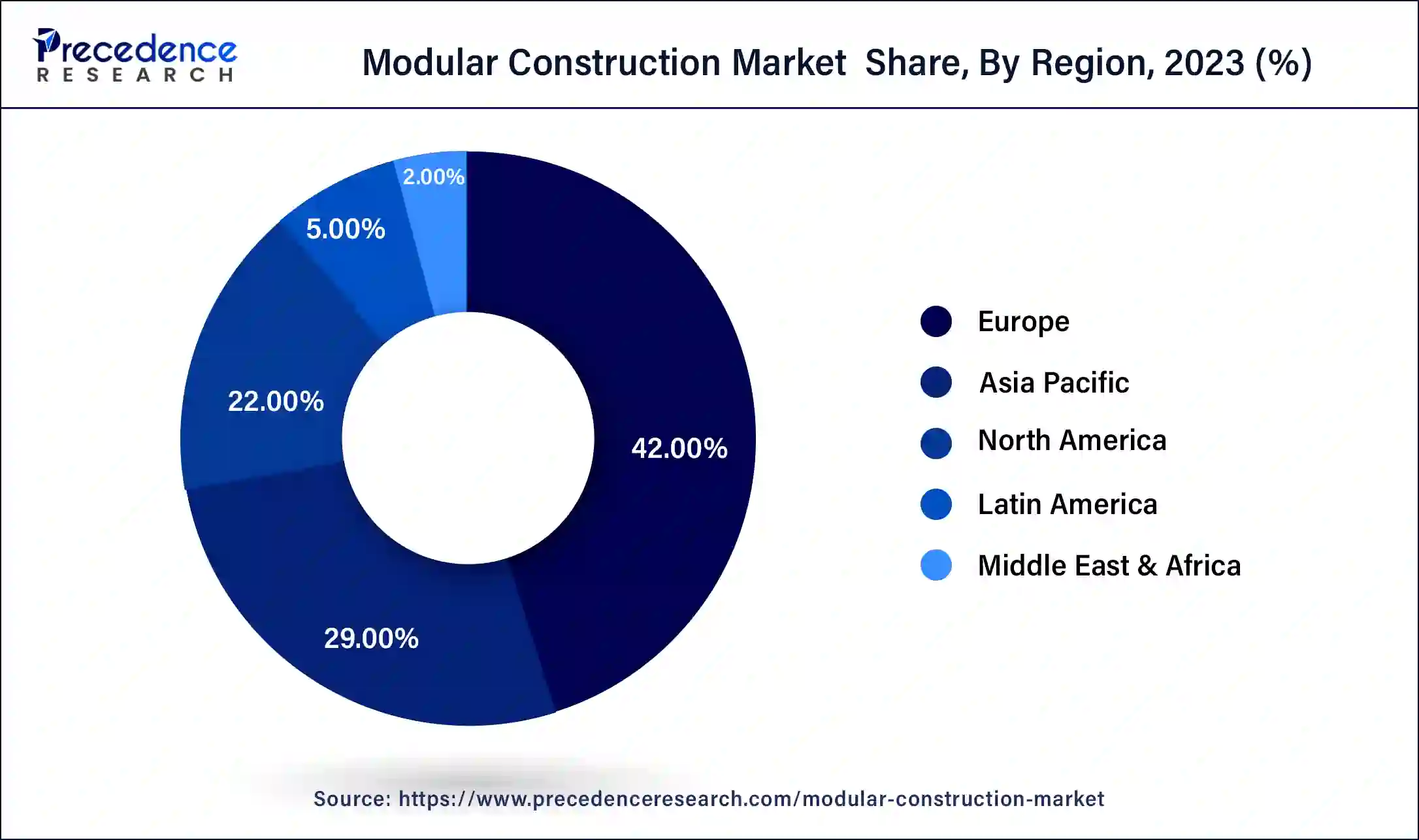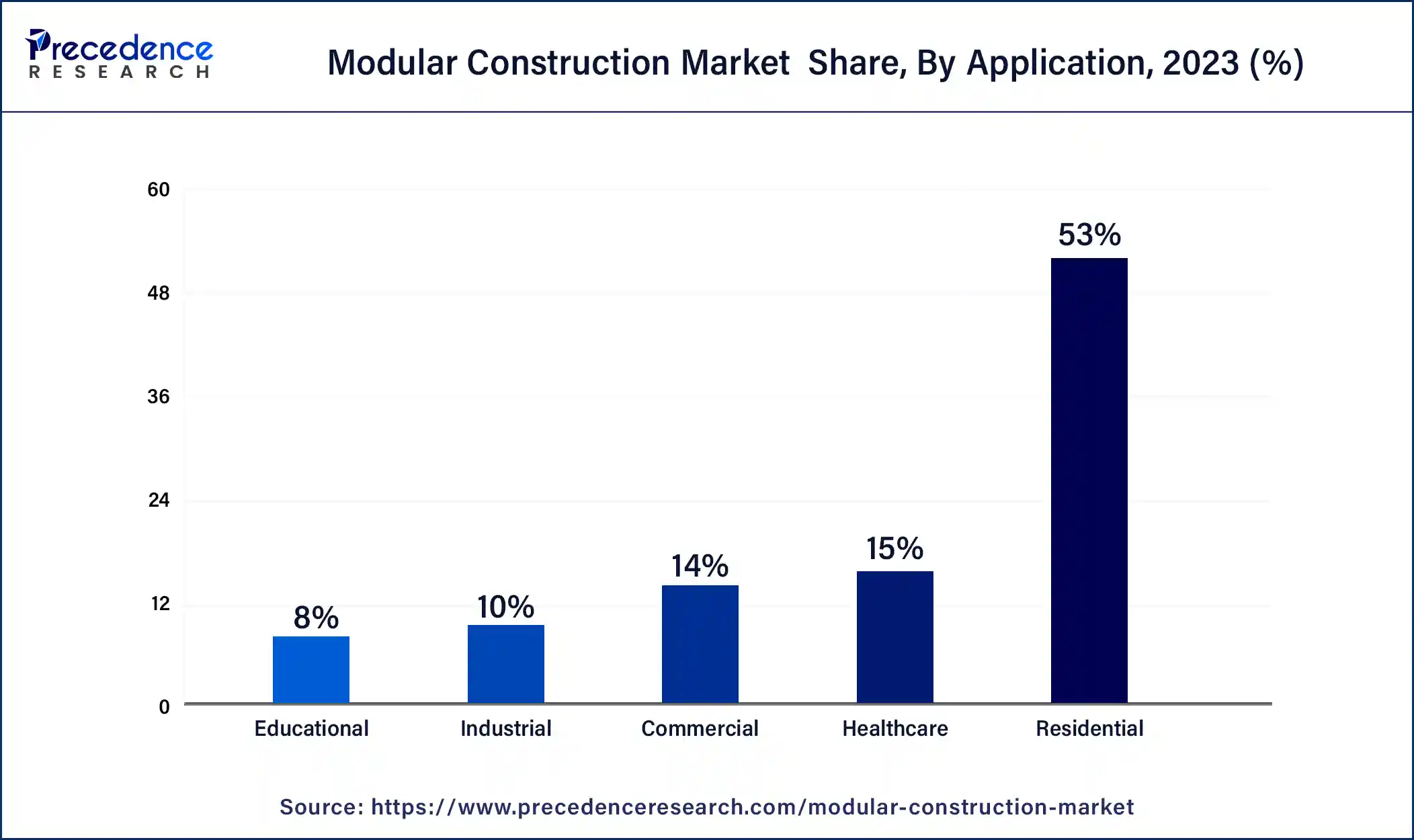September 2024
Modular Construction Market (By Product: Relocatable, Permanent; By Material: Wood, Steel, Concrete, Others; By Application: Residential, Commercial, Industrial, Healthcare, Educational) - Global Industry Analysis, Size, Share, Growth, Trends, Regional Outlook, and Forecast 2024-2034
The global modular construction market size was USD 97.31 billion in 2023, calculated at USD 104.65 billion in 2024 and is expected to reach around USD 214.76 billion by 2034, expanding at a CAGR of 7.45% from 2024 to 2034. This growth is linked to the growing demand for affordable housing coupled with the increasing investment in the development of healthcare and commercial infrastructure around the globe.

The Europe modular construction market size was estimated at USD 40.87 billion in 2023 and is projected to surpass around USD 90.20 billion by 2034 at a CAGR of 8% from 2024 to 2034.

Europe contributed more than 42% of the market share in 2023, largely due to high adoption rates in countries like Germany, Finland, the U.K., and Sweden. The main driving force behind this growth is the increasing influx of migrants, necessitating the development of both temporary and permanent housing structures. Furthermore, factors such as significant investments and the adoption of advanced technologies contribute to the expansion of the modular construction market in Europe. In the U.K., modular construction is gaining traction as an effective method for building affordable homes. This trend is driven by factors like population growth and housing shortages.

Asia Pacific is predicted to witness the fastest growth in the modular construction market, with a significant CAGR over the forecast period. This is linked to factors such as the expansion in the commercial and residential construction sector. Also, the increase in investments in the industry by market players, as well as government funding, drive the growth of the market in the region.
Modular construction involves creating prefabricated homes or structures using the same materials and design principles as traditional building methods. These structures are assembled using modules that are constructed off-site in a controlled environment. When all modules are combined, they match the exact design specifications required by building codes and standards. This method allows for efficient and consistent construction, ensuring that the final structure meets the same quality standards as those built on-site.
Modular structures can be easily taken apart, renovated, and moved for new modular homes, which reduces the need for raw materials and energy in building new structures. Modular construction, being controlled in factories, produces less waste and minimizes disruption on-site. With site work and modular building happening simultaneously, projects can be completed in half the time compared to traditional methods.
| Report Coverage | Details |
| Global Market Size by 2034 | USD 214.76 Billion |
| Global Market Size in 2023 | USD 97.31 Billion |
| Global Market Size in 2024 | USD 104.65 Billion |
| Growth Rate from 2024 to 2034 | CAGR of 7.45% |
| Largest Market | Europe |
| Base Year | 2023 |
| Forecast Period | 2024 to 2034 |
| Segments Covered | Product, Material, Application, and Region |
| Regions Covered | North America, Europe, Asia-Pacific, Latin America, and Middle East & Africa |
Rise in urbanization and industrialization with an increase in the speed of construction and high efficiency
Modular construction, a modern method gaining popularity in building homes and businesses, is considered revolutionary. The increasing urbanization and industrialization have boosted economies, leading to a surge in demand for modular buildings. These structures are preferred because they are quicker to construct, resulting in lower overall costs.
With developing regions like Asia, Latin America, and Africa experiencing rapid population growth and urbanization, there's a significant rise in demand for housing, infrastructure, and social services. Modular construction allows designers to select parts based on effectiveness, saving time and money. Its efficiency and durability make it a preferred choice among professionals, which contributes to the growth of the modular construction market.
Lack of reliability in earthquake-prone areas and lack of skilled labor
The modular construction market faces challenges related to earthquakes due to their lightweight module units and construction methods. Precast frame panels may not withstand strong earthquakes, and roofs and walls made of light materials like wood or metal can bend and deform. Consequently, modular construction is less prevalent in earthquake-prone areas.
Fear of technology and logistical issues also hinder market growth. Large projects like distribution centers may encounter difficulties with logistics, while smaller commercial projects in earthquake-prone areas find modular construction impractical and costly. These limitations pose significant barriers to the overall growth of the modular construction market.
The growth of the commercial sector
The market for modular construction is expanding as a result of the rising interest in this controlled environment alternative to on-site difficulties such severe weather. Similar to this, the market for modular construction is expanding due to the increased need for alternative construction systems brought about by the increase in construction expenses associated with green buildings.
Building operations in fields like hotels, offices, schools, etc. have increased as a result of the commercial sector's explosive growth, which has increased demand for this kind of building activity and fueled market expansion. Additionally, modular building is a popular option in contractual construction, which propels market growth, and is more favored for projects with stringent deadlines.
Rise in demand for eco-friendly buildings
The modular construction market is fueled by the growing demand for environmentally friendly and energy-efficient buildings. Modular techniques allow for recycled and sustainable materials, reducing the environmental impact of construction. With greater awareness of environmental sustainability and the popularity of Green Building certifications like LEED and BREEAM, the modular construction market is predicted to grow rapidly. Additionally, the rising demand for high-strength materials such as high-strength steel, composites, and structural steel, known for their lightweight and strong properties, is expected to drive market growth.
The permanent modular construction segment dominated the modular construction market in 2023. Permanent modular homes are made of wood, steel, and concrete. These houses are now becoming a popular trend among consumers because of their cost-effective, easy, and convenient features. Furthermore, modular houses are inexpensive and easy to put with one another and are available in different patterns and styles. Shipping containers are also being used by a lot of competitors and builders, which contributes to market growth.
In the modular construction market, the relocatable product segment is expected to grow at a significant rate for the forecast period. These structures can act as temporary housing for relief, and emergency operations have gained demand over the last decade. This building is made to be transported to various building sites. Such conveniences with regard to ease of construction and transportation make this segment popular among rescue and relief organizations.
The steel segment held the largest share in the modular construction market in 2023. Steel is utilized in various forms, such as columns, I-beam shapes, angles, and T-shapes. This material possesses outstanding mechanical and chemical properties, including durability, high strength, ductility, seismic resistance, ease of fabrication, and fast erection speed. It is commonly used as a reinforcing material in concrete to offset its low tensile strength.
The wood material segment is anticipated to grow at a substantial rate in the modular construction market during the projected period. Due to its strong compressive strength and ability to bend, wood modular construction is gaining popularity in commercial buildings, single-family homes, and urban housing. The ease and speed of designing high-quality wood structures are significant factors driving market growth. Additionally, prefabricated wood products offer greater accuracy in size compared to materials like steel and concrete, contributing to the rapid growth of the market.
The residential segment was credited for the largest share of the modular construction market. This is attributed to the focus on sustainability and aesthetics while constructing the buildings. It also includes single-family houses, rental housing properties, and multi-story buildings. The industry is seeing the rapid adoption of residential applications with reduced building costs and time.

Commercial modular construction has become increasingly popular in recent years, particularly in key markets like the U.K., the U.S., and Asia. The improving economic conditions in these regions are driving demand for commercial spaces such as offices, showrooms, and hotels, resulting in increased commercial building activities.
Segments Covered in the Report
By Product
By Material
By Application
By Geography
For inquiries regarding discounts, bulk purchases, or customization requests, please contact us at sales@precedenceresearch.com
No cookie-cutter, only authentic analysis – take the 1st step to become a Precedence Research client
September 2024
November 2024
February 2025
November 2024